Components: The Building Blocks of Every Bike
Table of Contents
Components are the parts that attach to a bike frame that provide all of the “functionality”. Components include: wheels, handlebar stem, handlebar, bottom bracket, crank arms, pedals, chainrings, chain, rear cassette, derailleurs, hanger, seat, seat stem, brakes, and levers. In some circles the fork is also considered a component, separate from the frame.
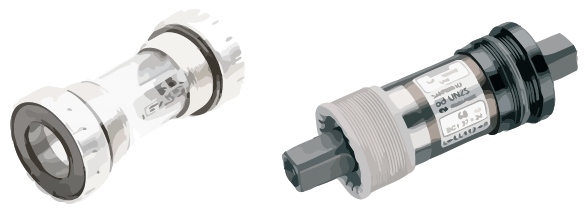 Bottom Brackets
Bottom Brackets Crankset, Chainrings, and Crank Arms
Crankset, Chainrings, and Crank Arms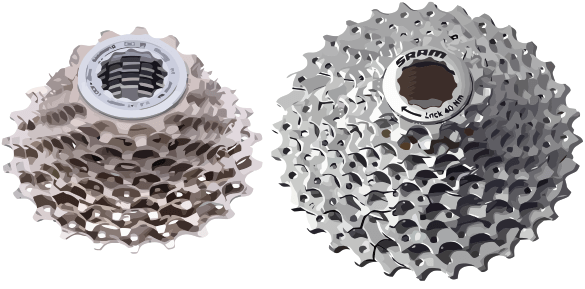 Rear Cassettes
Rear Cassettes Rear Derailleur
Rear Derailleur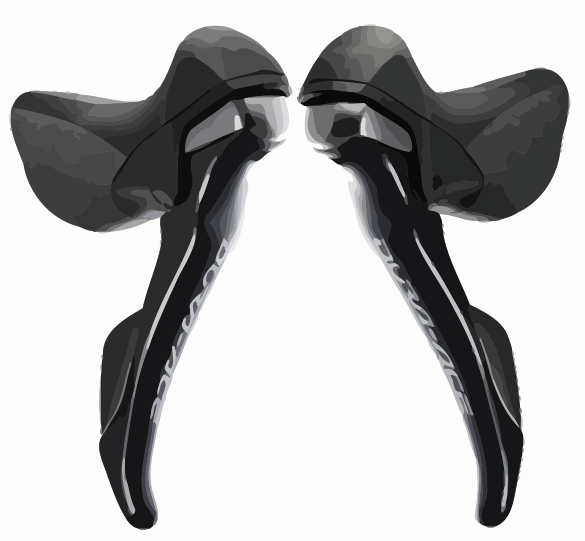 Dual Gear and Brake Levers
Dual Gear and Brake LeversThe quality of the components will go a long way into determining the quality of the bike's feel and weight. Some might even say that the components are as important, or maybe more so, than the frame. For example, going from an aluminum frame to a carbon frame can provide a decrease in weight, but changing the standard wheels that come with a bike to high-end wheels would provide an even bigger benefit.
The material that components are made of can be steel, aluminum, carbon, and even titanium. Many top-end distributors offer the option for you to choose the frame and the components separately and will then assemble everything before shipping. If you really know what you're doing, you can buy all of the parts separately, including the frame, and assemble it yourself.
The Major Component Manufacturers
In the world of cycling there are three major companies that design, manufacture, and distribute components. In the order from largest to smallest, these are Shimano, SRAM, and Campagnolo. Although Shimano is the largest company, it is hard to determine if one company is superior to another, as they all produce lower-end and top-of-the-line products. The choice is usually personal preference.
Shimano is the largest components company. Established in 1921 in Japan, it now holds 50% of the global market. It produces components for road bikes, mountain bikes, and hybrids. Shimano is mostly known for the Shimano Index Shifting (SIS) innovation in 1984, where gears ‘click' into place, making gear changing much easier. In addition to bicycle components, it also produces fishing gear and rowing equipment.
At present Shimano produces the following lines for road bikes, from entry level to professional: Claris, Sora, Tiagra, 105, Ultegra, and Dura-Ace. In addition to cable shifting, electronic shifting is also available for the Ultegra and the Dura-Ace lines.
For mountain bikes Shimano produces the following lines: TX Range, Altus, Acera, Alivio, Deore, SLX, XT, and XTR.
SRAM, a U.S. company established in 1987 grew over the years by acquiring other bicycle components companies, rather than innovating its own products. SRAM stands for Scott, (Stan) Ray, and Sam.
At present, SRAM produces the following lines for road bikes, from entry level to professional: Apex, Rival, Force, and Red. At the moment, SRAM has not made available electronic shifting.
For mountain bikes SRAM produces the following lines: X-3, X-4, X-5, X-7, X-9, x-0, and XX.
Campagnolo is an Italian company established in 1933 by Tullio Campagnolo. It focuses on road and track bikes. The company used to produce components for MTBs but left that part of the market in 1994. It's mostly known for its quick release system invented in 1930.
At present Campagnolo produces the following lines for road bikes, from entry level to professional: Xenon, Veloce, Athena, Chorus, Centura, Record, and Super Record. Campagnolo also has electronic shifters, called Electronic Power Shift (EPS).
Road Bike Dual Brake and Gear Levers Explained
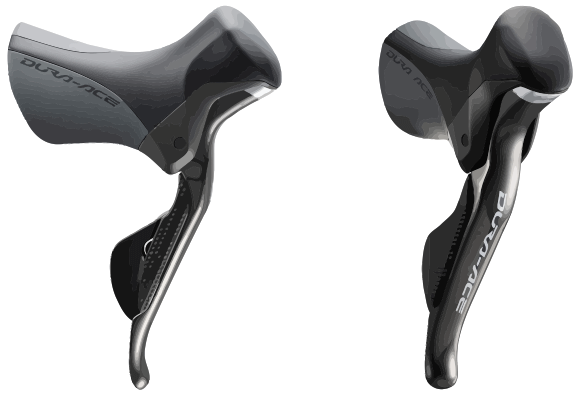 Shimano Top-of-the-Line Dual Brake and Gear Lever
Shimano Top-of-the-Line Dual Brake and Gear LeverShimano has two levers on each handle. The larger lever acts as the brake lever and also as a gear lever. When you pull the lever towards the bar you engage the brakes. When you pull the lever inwards you engage the gears — left lever controls the front derailleur and the right lever controls the rear derailleur.
To move the chain to the larger cog (harder gear) on the crankset you pull the left large lever inward. To move the chain to the smaller cog (easier gear) on the crankset you pull the left smaller lever inward. To move the chain to a larger cog (harder gear) on the rear cassette you pull the right large lever inward. To move the chain to a smaller cog (harder gear) on the rear cassette you pull the right smaller lever inward.
For the rear derailleur, you can shift to more than one larger cog at a time, simply by pulling the lever further in.
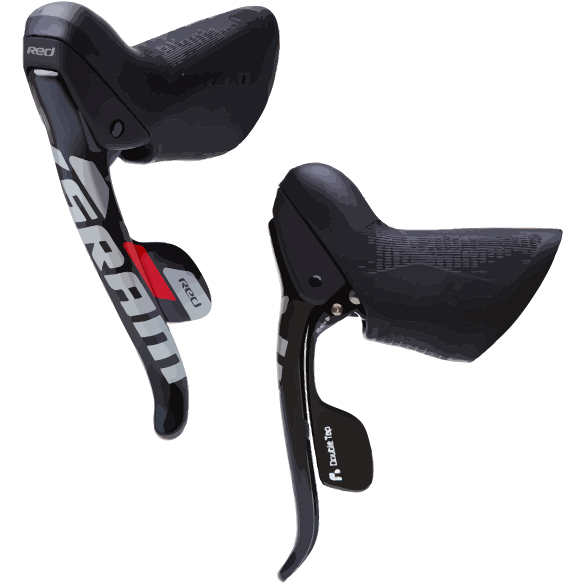 SRAM Top-of-the-Line Dual Brake and Gear Lever
SRAM Top-of-the-Line Dual Brake and Gear LeverSRAM Gear Levers are a little bit different. The largest lever only controls the brakes. The smallest lever controls the gears. The left for the front derailleur and the right for the rear derailleur. And they only move inwards.
For the front derailleur, to shift to a larger cog (harder gear) you would pull the lever using a long swipe, which will be a double click, where as to move to a smaller cog (easier gear) you would pull the lever with a short swipe, a single click.
For the rear derailleur, to shift to a smaller cog (harder gear), you would pull the lever using a long swipe, double click. And to shift to a smaller cog (harder gear), you would pull the lever with a short swipe, single click.
A really cool function that SRAM has designed into its top end gear/brake levers is that you can adjust how far the levers are from the bars. So, if you have small hands you can bring the levers closer.
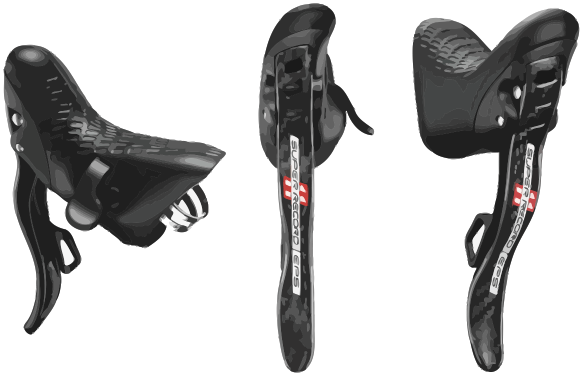 Campagnolo Top-of-the-Line Dual Brake and Gear Lever
Campagnolo Top-of-the-Line Dual Brake and Gear LeverCampagnolo Gear Levers are a little bit simpler than both Shimano and SRAM, but by no means of lower quality. The brake lever only controls the brakes. The second smaller lever controls the gears when you want to move to a harder gear. For the front gear, pull the left lever inwards when you want to shift to a larger cog (harder gear). When you want to shift the chain to the smaller cog (easier gear), use the little button on the side with your left thumb.
For the rear gears, pull the right lever inwards when you want to shift to a larger cog (easier gear). When you want to shift to a smaller cog (harder gear), again, press the button on the side with your right thumb.
A unique aspect of the Campagnolo right shifter is that by holding the lever, or button, down longer it will shift more than one gear.
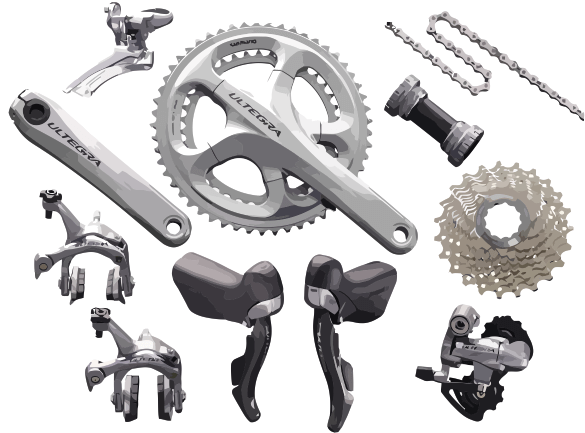 Shimano Groupset
Shimano GroupsetGroupsets
In addition to being able to purchase individual components, you can purchase entire sets. This is a good option if you have a good quality frame, with lots of life left in it, but want to upgrade all of the components. Purchasing a groupset will be less expensive than purchasing each component individually, and you are guaranteed compatibility.
A groupset generally contains the brakes and levers, derailleurs, chain, rear cassette, chainrings, crank arms, and bottom bracket. Pedals, hubs, and wheels are typically not included in a groupset.
The price of a groupset can vary from just a couple of hundred dollars to thousands of dollars. The difference will be in weight, strength, durability, and quality such as crisp shifting and stiffness. Things like hydraulic brakes, which is starting to enter the road bike market, and electronic shifting would both increase the price.
If weight wasn't a factor manufacturers could just use hardened steel. Because there is a huge demand for light components, manufacturers need to use more expensive, lighter materials. In addition, these lighter materials may require expensive processes in order to strengthen them. This is the main reason for the high price of some groupsets. As an example, the groupset Shimano Di2 can cost around $3700 US. And that's without wheels or pedals, stems, bars, seats…



Leave a Reply